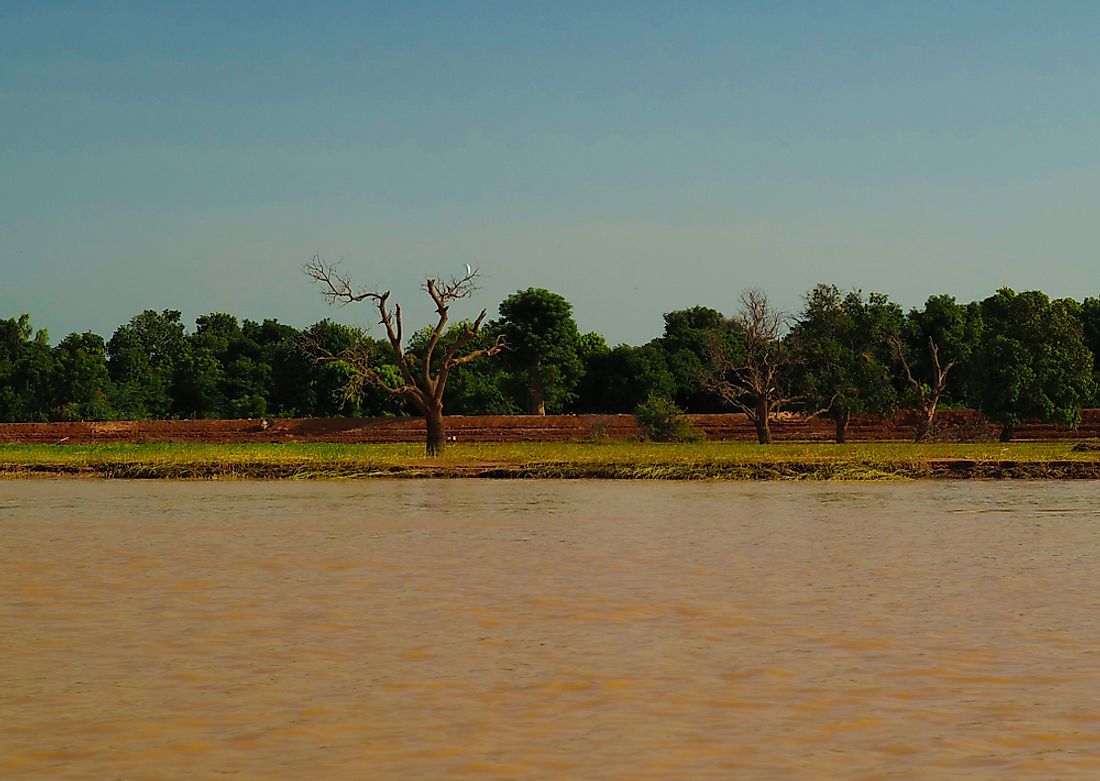Where is the Niger River?

5. Description
The length of the Niger River is around 4,100 kilometers, according to Food and Agriculture Organization (FAO), making it Africa’s third largest river after the Nile and Congo. In West Africa, it’s the longest and largest river, and is nicknamed the "Boomerang River" due to its serpentine shape. Niger, Guinea, Cote de Ivoire, Mali, Burkina Faso, Algeria, Benin, Chad, Cameroon, and Nigeria are the ten African countries that the river runs through. The Niger River Basin covers 7.5 percent of the African continent, and its main tributary is the Benue River. The Niger River's source is 150 miles inland from the Atlantic Ocean, from where the river detours into the Sahara desert, taking a sharp right turn near Mali’s Timbuktu city, and then flowing southeast into the Gulf of Guinea.
4. Historical Role
The first European to discover Niger River was Mungo Park in the 1790s. However, the Lander Brothers, Richard and John, were the first Europeans to follow the river all the way to its delta. Mali’s capital, the city of Bamako, was built on both sides of the Niger River. The city came to being in the 19th Century, when French colonialists settled along the river. Bamako was then but a tiny village with a few local residents, but it grew over the years, largely due to the Niger River’s economic importance. The river was used for transportation, fishing, market gardening, sand extraction, and as a trade route, according to the Royal Geographical Society.
3. Modern Significance
In modern times, the Niger River sustains a population estimated to stand at over 100 million in the countries that it flows through. Agriculture and fisheries are the most common forms of livelihood and economic activities along the river. According to Wetlands International, when the Niger River floods annually, the Inner Niger Delta in Mali alone provides fish, alongside water for household and agricultural use, to around 1.5 million people. The river has an irrigation potential of over 2.8 million hectares as well, according to FAO estimates. There also are nearly 250 freshwater fish species in the river, of which 20 are only found there in the whole world, making them endemic to the region, according to World Wildlife Fund (WWF). Millions of migratory birds also depend on the river for seasonal sustenance and shelter.
2. Habitat
There are diverse habitats along the flows of the Niger River. Besides supporting people and their livestock, these habitats are diverse with flora and fauna. The swamps, lakes, and delta channels here support numerous migratory palearctic and wetland bird species, as well as such mammals as the West African manatee (or Sea-cow) and Pygmy hippo. Waterfowls, herons, spoonbills, Black-crowned cranes, and ibises are other bird species spread across the vast Niger River Basin's ecosystems, in addition to the endemic, non-wetland, Mali fire-finch. In the inner Niger Delta, submerged, partially submerged, and marginal vegetation are rife there, alongside the algal blooms that dot the lake. Grasses like Acroceras, Amplectens, Echinochloa pyramidalis, and Erasgrostis atroviriens are found in the low-lying floodplains of the Niger River Delta. Trees, like species of Diospyros, Kigelia Africana, Acaicia nilotica, and Mimosa asperata, also grow along the Niger River.
1. Threats and Disputes
The entire Niger River Delta and its ecosystems face threats brought by oil and gas exploration, deforestation, industrial pollution, population expansion, urbanization, industrialization, coastal erosion, sand mining, and water hyacinth invasions upon native flora, according to the WWF. Water flow continues to be under threat here as well, as further dams are still being proposed to be built to generate hydroelectric power and to irrigate croplands. This is more pronounced in the upper Niger in Guinea, Conakry, and Southern Mali, where water meant for the inner Niger Delta is diverted. These human activities have resulted in diminished water levels and scarcity for humans, and habitat alteration for wildlife. This has placed the livelihoods of many households along the affected areas under threat, as well as the lives of livestock and wildlife. According to the WWF, annually the population along the river is expanding at an average rate of 3 percent, thereby putting enormous amounts of pressure on the natural resources of the Nile River Basin. In 1985, these human activities contributed to the river drying up for several weeks in Malanville in the Benin Republic, though this was likely just a warning of greater catastrophes to come if these issues are not dealt with on and around the Nile River.











